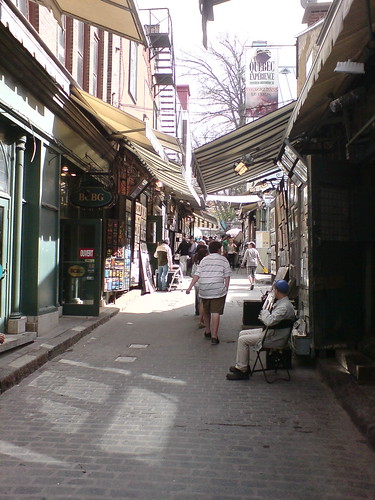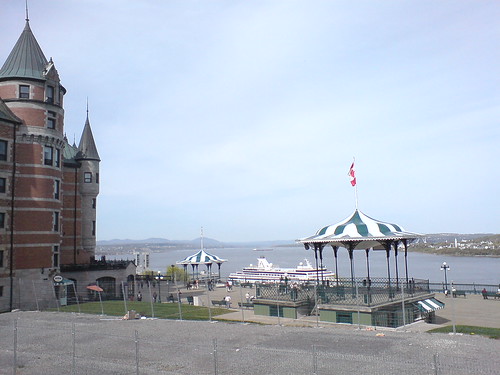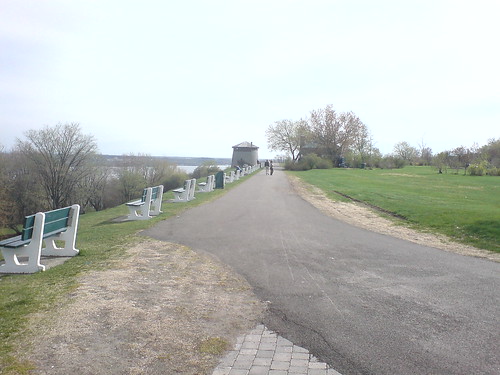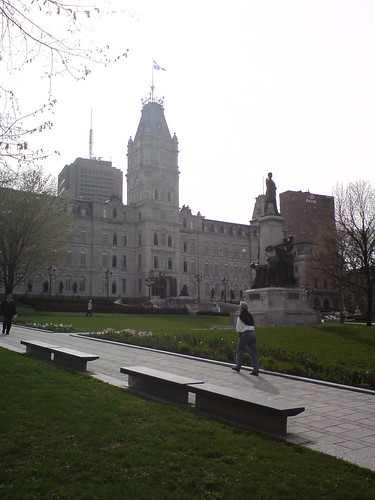
Arriving in Quebec City in the middle of the afternoon, my second stop on my way to Fredericton, I was immersed in the city’s history before I even saw its skyline, with a radio station dedicated to promoting the city’s heritage playing in the car — Quebec’s Tourism Radio, FM 89.7. After a long drive, I just wanted to roll out of the car and onto a patio to grab a glass of wine, but having never been to the Quebec City, I decided not to pass up the opportunity to see one of the oldest European settlements in Canada (only St. John’s, NF, Tadoussac, PQ, and Port Royal, NS, are older), founded 400 years ago this year by Samuel de Champlain.

Parking underneath the Hotel de Ville in Vieux-Quebec, I started my walk by wandering up to the Chateau Frontenac, where I grabbed a map that pointed out the sights of interest nearby. Behind the Chateau, after taking in the expansive view of the St. Lawrence River, I walked up the Governor’s Walk (so named because of its proximity to former and current residences of the Governor General, including the still-in-use summer residence of the Governor General in la Citadelle), which was opened to celebrate the city’s 350th birthday in 1958 (for the 400th year la Promenade Samuel-De Champlain, as well as a few other major projects, are in progress but were not yet open during my visit). The Governor’s Walk was interesting because it links Vieux-Quebec, via the Chateau, to la Citadelle and the Plains of Abraham (originally designated as a park to celebrate the city’s 300th anniversary). Running along a cliff, the walk is fairly steep, but offers rewarding views and plenty of rest areas with benches to sit down.

At the top of the walk, looking over the plains from the grass topped ramparts of la Citadelle, I was really impressed by how the park has both maintained its history yet serves a vital role in the ongoing life of the city. Walking trails traverse the rolling hills of the plains, between architectural artifacts and monuments, but it doesn’t feel feel stifled in its obligations to preserve the past, instead it feels well used, by tourists (of which there were more than lots in Vieux-Quebec) as well as by people who live in the city.
In the park I found a Martello Tower, much like the ones I saw in Kingston, only built three decades earlier after the Anglo-American crisis of 1807. Three of the original four still remain in Quebec City, one of which I saw later in a nearby street, surrounded by large homes.

I walked back into the old city past the Quebec Parliament building, a rare North American example of the ornate Second Empire style, admiring not only the architecture but the generous yet comfortable plaza in front of it. Entering the old city again, I took a moment and walked along the top of the surrounding old rampart, covered in grass and well enjoyed by people playing guitars, taking in the sunshine, or spending time with friends and loved ones (somewhat ironically between the canons that still sit within the top of the wall).

It was an interesting experience and a great example of how artifacts such as the wall, though no longer needed for their original function, contribute immeasurably to the overall appearance and experience of a city as long as people put a little imagination to how they can be re-used.












9 comments
I’ll be there this weekend, so I appreciate the timing of this!
Sean > There is an incredible amount to see in Quebec City – I am only sorry that I wasn’t there longer to check more of it out.
It is interesting that the “tourist” photos of any city seems to be older, pedestrian friendly neighbourhoods and not the asphalt deserts of suburbia.
I was just in Quebec City last weekend. It wasn’t as cheap as other potential trips but it was well worth it.
It’s a beautiful city that doesn’t have a peer in North America.
The last time I was in Quebec was at conference at Laval University a few years ago – the only bright side was the frequent 200/201 Metrobus service to the Old City. (Laval for the most part is about as urban as University of Waterloo, but the tunnel system there is more interesting).
Quebec City has more malls and freeways than one would expect for a metropolitan area of 650,000, and in this way, feels like a midwest US city. It also seems to have some of Canada’s worst sprawl, worse than Ottawa or Calgary. Yet perhaps it has allowed the old city and the immediate area to remain as is without too much interference with auto traffic and commercial development.
I find Quebec City the kind of place one can visit for 48 hours and see everything there is worth seeing (unlike Montreal, where’s there always seems to be something new to find), but it is worth seeing.
Old Quebec is fascinating but I never thought that, contrary to claims by travel magazines, it looked French (whatever a French look is as each area of France has actually an architectural style different from other regions). Then I read the special issue (Quebec city 400th birthday)of the Quebec magazine l’Actualite. An article explains that the city was extensively restored in the 19th century and that many buildings are in the English style (or to me, a North American version of English style). Google lactualite.com then, under photos reportages, le vieux-Quebec heritage britannique? Novembre 2007. As others have commented, Quebec city, outside the older areas,is a typical CANADIAN city and the Quebecois are just like other Canadians.
dont tell the quebecois that. they think they are something special.
and they certainly dont sound like canadians. man, that french is a turnoff, and rather embarrassing for canadians.
Sean > I spent the night at Univerité Laval in one of their dorms (it operates as a hostel during the summer). The only part of the tunnel system I saw was interesting because it was covered in murals (giving a very utilitarian space quite a bit of character).
The sprawl in the part of the city where Laval is located was a huge contrast to the historic downtown. Hard to reconcile the two parts of the city.
Re Quebec’s c19 “restoration”: I’m not sure if it’s Franco-Quebec revisionist chauvinism in play with the business of “English style”–if anything, the present spiffed-up tourist-friendly aspect of the walls and ramparts, et al, owe just as much to the spirit of Viollet-Le-Duc’s restorations in France. Though yes, the “chateau style” as embodied by the Chateau Frontenac always had that Scottish-French fusion thing going.
How’s the burnt-out Armory doing?
Also, for anyone roadtripping to/via Quebec City: if you can track it down, I’d recommend a picnic/pitstop at the park overlooking the Quebec Bridge from the NE–and if you’re into something really sublime, maybe a stroll down to and even across the bridge. (NB: it’s closer to Laval University than Old Quebec is. But “walkably” close only if you’re a suburban-psychogeography masochist with plenty of time to spare–though I *would* recommend, as a worthy stamina exercise, a walk from Laval U into Quebec City. The Chemin Ste Foy’s the best i.e. most “urban” option for that: think of it like walking to Yonge-Dundas Square from the Junction, or something.)
(And I took a French summer programme at Laval in the summer of ’85, so I know of what I speak.)